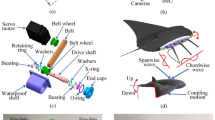Abstract
This paper investigates the performance of the dual mode, namely flipper mode and central pattern generator (CPG) mode, for controlling the depth of a gliding robotic dolphin. Subsequent to considering the errors in dynamic models, we propose a depth control system that combines the line-of-sight (LOS) method with an adaptive control approach (ACA) to deal with uncertainties in the model parameters. First, we establish a full-state dynamic model to conduct simulations and optimize the parameters used in later aquatic experiments. Then, we use the LOS method to transform the control target from the depth to the pitch angle and employ the ACA to calculate the control signal. In particular, we optimize the ACA’s control parameters using simulations based on our dynamic model. Finally, our simulated and experimental results demonstrate not only that we can successfully control the robotic dolphin’s depth, but also that its performance was better than that of the CPG-based control, thus indicating that we can achieve three-dimensional motion by combining flipper-based and CPG-based control. The results of this study suggest valuable ideas for practical applications of gliding robotic dolphins.
Similar content being viewed by others
References
Ijspeert A J. Biorobotics: using robots to emulate and investigate agile locomotion. Science, 2014, 346: 196–203
Wu Z X, Yu J Z, Su Z S, et al. Towards an Esox lucius inspired multimodal robotic fish. Sci China Inf Sci, 2015, 58: 052203
Yuan J, Yu J Z, Wu Z X, et al. Precise planar motion measurement of a swimming multi-joint robotic fish. Sci China Inf Sci, 2016, 59: 092208
Zhang A F, Ma S G, Li B, et al. Adaptive controller design for underwater snake robot with unmatched uncertainties. Sci China Inf Sci, 2016, 59: 052205
Yu J Z, Li X B, Pang L, et al. Design and attitude control of a novel robotic jellyfish capable of 3D motion. Sci China Inf Sci, 2019, 62: 194201
Liu J C, Wu Z X, Yu J Z, et al. Sliding mode fuzzy control-based path-following control for a dolphin robot. Sci China Inf Sci, 2018, 61: 024201
Nagai M. Thinking Fluid Dynamics with Dolphins. Tokyo: Ohmsha, 2002
Yu J Z, Su Z S, Wang M, et al. Control of yaw and pitch maneuvers of a multilink dolphin robot. IEEE Trans Robot, 2012, 28: 318–329
Yu J Z, Su Z S, Wu Z X, et al. An integrative control method for bio-inspired dolphin leaping: design and experiments. IEEE Trans Ind Electron, 2016, 63: 3108–3116
Eriksen C C, Osse T J, Light R D, et al. Seaglider: a long-range autonomous underwater vehicle for oceanographic research. IEEE J Ocean Eng, 2001, 26: 424–436
Sherman J, Davis R E, Owens W B, et al. The autonomous underwater glider “Spray”. IEEE J Ocean Eng, 2001, 26: 437–446
Webb D C, Simonetti P J, Jones C P. SLOCUM: an underwater glider propelled by environmental energy. IEEE J Ocean Eng, 2001, 26: 447–452
Leonard N E, Paley D A, Davis R E, et al. Coordinated control of an underwater glider fleet in an adaptive ocean sampling field experiment in Monterey Bay. J Field Robot, 2010, 27: 718–740
Grasso R, Braca P, Fortunati S, et al. Dynamic underwater glider network for environmental field estimation. IEEE Trans Aerosp Electron Syst, 2016, 52: 379–395
Wu Z X, Yu J Z, Yuan J, et al. Mechatronic design and implementation of a novel gliding robotic dolphin. In: Proceedings of IEEE International Conference on Robotics and Biomimetics, Zhuhai, 2015. 267–272
Wu Z X, Yu J Z, Yuan J, et al. Towards a gliding robotic dolphin: design, modeling, and experiments. IEEE/ASME Trans Mechatron, 2019, 24: 260–270
Yuan J, Wu Z X, Yu J Z, et al. Sliding mode observer-based heading control for a gliding robotic dolphin. IEEE Trans Ind Electron, 2017, 64: 6815–6824
Shen F, Cao Z Q, Zhou C, et al. Depth control for robotic dolphin based on fuzzy PID control. Int J Offshore Polar Eng, 2013, 23: 166–171
Ranganathan T, Singh V, Thondiyath A. Theoretical and experimental investigations on the design of a hybrid depth controller for a standalone variable buoyancy system-vBuoy. 2018. doi: https://doi.org/10.1109/JOE.2018.2875576
Yu J Z, Liu J C, Wu Z X, et al. Depth control of a bioinspired robotic dolphin based on sliding-mode fuzzy control method. IEEE Trans Ind Electron, 2018, 65: 2429–2438
Yu J Z, Wang M, Tan M, et al. Three-dimensional swimming. IEEE Robot Autom Mag, 2011, 18: 47–58
Makrodimitris M, Aliprantis I, Papadopoulos E. Design and implementation of a low cost, pump-based, depth control of a small robotic fish. In: Proceedings of IEEE International Conference on Intelligent Robots and Systems, Chicago, 2014. 1127–1132
Yu J Z, Sun F H, Xu D, et al. Embedded vision-guided 3-D tracking control for robotic fish. IEEE Trans Ind Electron, 2016, 63: 355–363
Wang J, Wu Z X, Yang Y Q, et al. Spiraling motion of a gliding robotic dolphin based on the 3-D dynamic model. In: Proceedings of IEEE International Conference on Real-time Computing and Robotics, Kandima, 2018. 13–18
Ijspeert A J, Crespi A, Ryczko D, et al. From swimming to walking with a salamander robot driven by a spinal cord model. Science, 2007, 315: 1416–1420
Verma S, Shen D, Xu J X. Motion control of robotic fish under dynamic environmental conditions using adaptive control approach. IEEE J Ocean Eng, 2018, 43: 381–390
Yu J Z, Yuan J, Wu Z X, et al. Data-driven dynamic modeling for a swimming robotic fish. IEEE Trans Ind Electron, 2016, 63: 5632–5640
Acknowledgements
This work was supported by National Natural Science Foundation of China (Grant Nos. 61421004, 61725305, 61633020, 61633017, 61603388) and Key Project of Frontier Science Research of Chinese Academy of Sciences (Grant No. QYZDJ-SSW-JSC004).
Author information
Authors and Affiliations
Corresponding author
Rights and permissions
About this article
Cite this article
Wang, J., Wu, Z., Tan, M. et al. Controlling the depth of a gliding robotic dolphin using dual motion control modes. Sci. China Inf. Sci. 63, 192206 (2020). https://doi.org/10.1007/s11432-019-2671-y
Received:
Accepted:
Published:
DOI: https://doi.org/10.1007/s11432-019-2671-y



